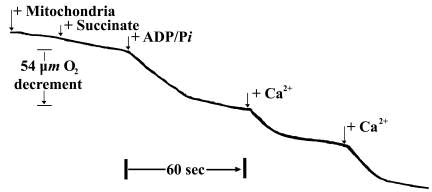Preface | Introduction to Problem Solving | Problem Sets | Acknowledgments
| G.2. Ca2+ and Respiration <<Previous Problem | PPDF |
2. (30 pts) During the classical period of bioenergetics research (1960’s),
Britton Chance and his students characterized what was then considered
a peculiar response of isolated, actively respiring mitochondria to the
addition of calcium ions. Consider the data from one of these experiments
and answer all the following questions.
Mitochondria, freshly isolated from guinea pig kidney, were resuspended
in a well-buffered isosmotic medium. An aliquot of this suspension was
then assayed polarographically, to determine the effect of various additives
on mitochondrial respiration (measured as oxygen reduction). The strip
chart recording below indicates changes in the level of oxygen dissolved
in the suspension as a function of time.
 |
A. (8 pts) Briefly describe the experimental results, and explain why
the addition of succinate and ADP and inorganic phosphate produce the
effects indicated.
B. (6 pts) The addition of calcium seems to mimic the effect of ADP and
inorganic phosphate. Propose a hypothesis to explain this effect.
C. (5 pts) What special membrane mechanism must mitochondria possess to
account for the calcium effect?
D. (5 pts) Suggest a concrete test of your hypotheses for either B. or
C. and describe clearly what the results would indicate.
E. (6 pts) What would be the effect of adding dinitrophenol (DNP) or a
proton ionophore just before the addition of ADP and inorganic phosphate?
Of adding it later, just before the addition of calcium?